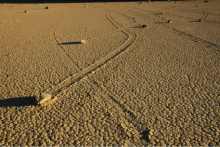Since the 1940s, scientists have been stymied by the cause of the “sliding stones” in California’s Death Valley. How, without human intervention, does a 700-lb boulder move from one place to another, leaving a distinctive, meandering trail? Finally, in August 2014, recorded pictures showed that the power of water, freezing and melting, actually moves these boulders.1 Those who treat kidney stones (nephrolithiasis) have always known the power of liquid to move “boulders.”
The Sliding Stones of Death Valley, California
The incidence of kidney stones in the United States has risen from 3.8% of the population in the 1970s to 8.8% of the population in the 2010s.2,3 Stones are three times more common in whites than in nonwhites and twice as common in men as in women.4 The cost of kidney stones in the US, including hospitalizations, surgery, and time lost from work, is calculated at $5 billion per year.5
Next page: History of treatment >>

